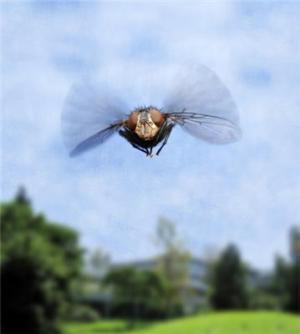Please note: Osher Rainforest will be closed for maintenance Jan. 14–16.
Science News
How do Flies Fly?
November 21, 2011

How does the fly fly? No really, how does it fly?
Researchers from the Max Planck Institute in Germany wondered how the fruit fly Drosophila melanogaster could fly so efficiently.
Compared to their body size, these flies have very small wings, which they move quite rapidly. In fact they move their wings at a frequency of 200 hertz—so the flight muscles contract and relax 200 times per second! “In contrast, a hundred meters sprinter who moves his legs only a few times per second moves like a snail,” Max Planck’s Frank Schnorrer describes.
How can the fruit fly flap its wings at such a high frequency?
Like the human sprinter, muscles control all body movements, including the wing oscillations. However, these flight muscles are unique. Their contractions are not only regulated by nerve impulses, but also triggered by tension.
Every fly has two categories of flight muscles that enable the wing oscillations: one type moves the wings down and, at the same time, stretches the other type that induces the wings’ contraction. Through this movement, the wings are pulled up again and stable wing oscillations begin.
To find the gene responsible for this specific muscle movement, the researchers received a little help, reports Physorg.com:
Using an ultra-microscope at the Vienna University of Technology… A genetic switch was discovered, which determines the muscle type… and the genes responsible for that kind of muscle type can be switched on and off by a protein.
“The gene spalt is essential for the generation of the ultrafast super muscles,” emphasizes Schnorrer. “Without spalt, the fly builds only normal leg muscles instead of flight muscles.”
Spalt only exists in flight muscles and is responsible for the specific architecture of their myofibrils. These components of muscle fibers alone enable the contraction of a muscle in response to the applied tension during the oscillations. Without spalt, the flies survive, but are flightless. The flight muscles no longer react to tension and thus behave like normal leg muscles. On the flip side, the scientists succeeded in creating flight muscle-like muscles in the fly’s legs simply by inserting spalt.
These results could be medically important, says Schnorrer.
Human body muscles do not have spalt and are hardly regulated by tension. But the human cardiac muscle builds spalt and the tension inside the ventricle influences the heartbeat intensity. Whether spalt plays a role in heartbeat regulation, is not yet known and remains to be investigated.
The research is published in the current edition of Nature.
Image: Frank Schnorrer/MPI of Biochemistry